If you need six minutes of comic relief, this might do the trick. For those who don’t get the underlying reference, watch here. Enjoy! :)
If you need six minutes of comic relief, this might do the trick. For those who don’t get the underlying reference, watch here. Enjoy! :)
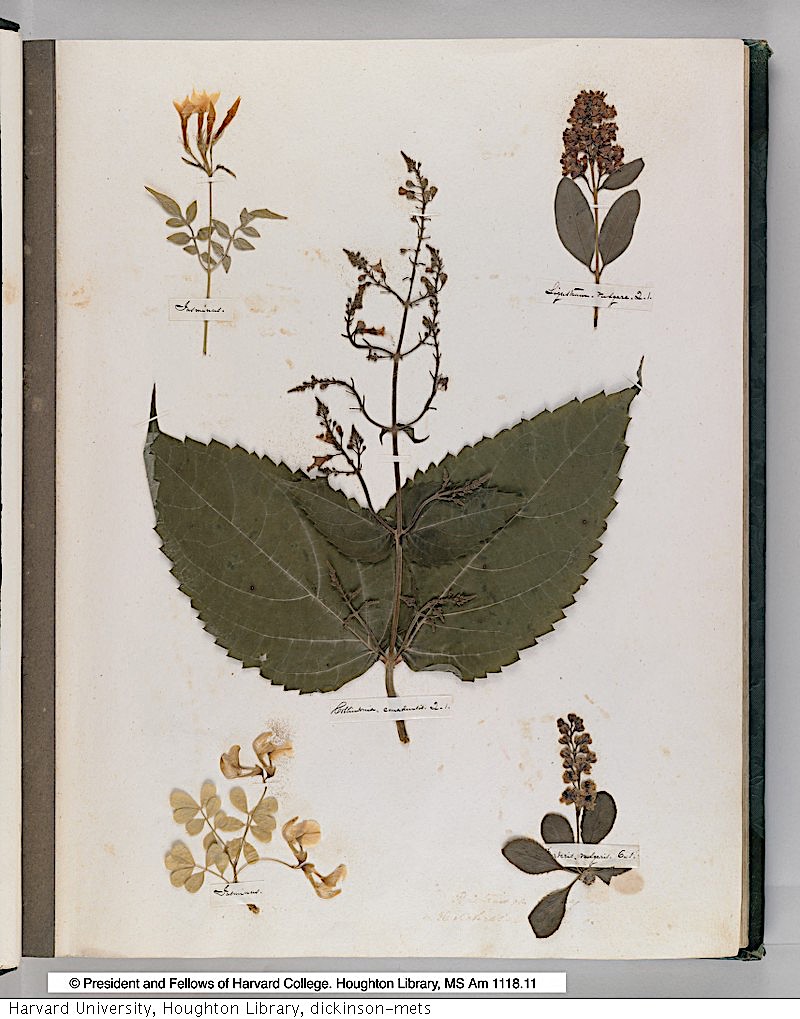
So many writers have been gardeners and have written about gardens that it might be easier to make a list of those who didn’t. But even in this crowded company, Emily Dickinson stands out. She not only attended the fragile beauty of flowers with an artist’s eye—before she’d written any of her famous verse—but she did so with the keen eye of a botanist, a field of work then open to anyone with the leisure, curiosity, and creativity to undertake it.
“In an era when the scientific establishment barred and bolted its gates to women,” Brain Pickings’ Maria Popova writes, “botany allowed Victorian women to enter science through the permissible backdoor of art.”
In Dickinson’s case, this involved the pressing of plants and flowers in an herbarium, preserving their beauty, and in some measure, their color for over 150 years. The Harvard Gazette describes this very fragile book, made available in 2006 in a full-color digital facsimile on the Harvard Library site:
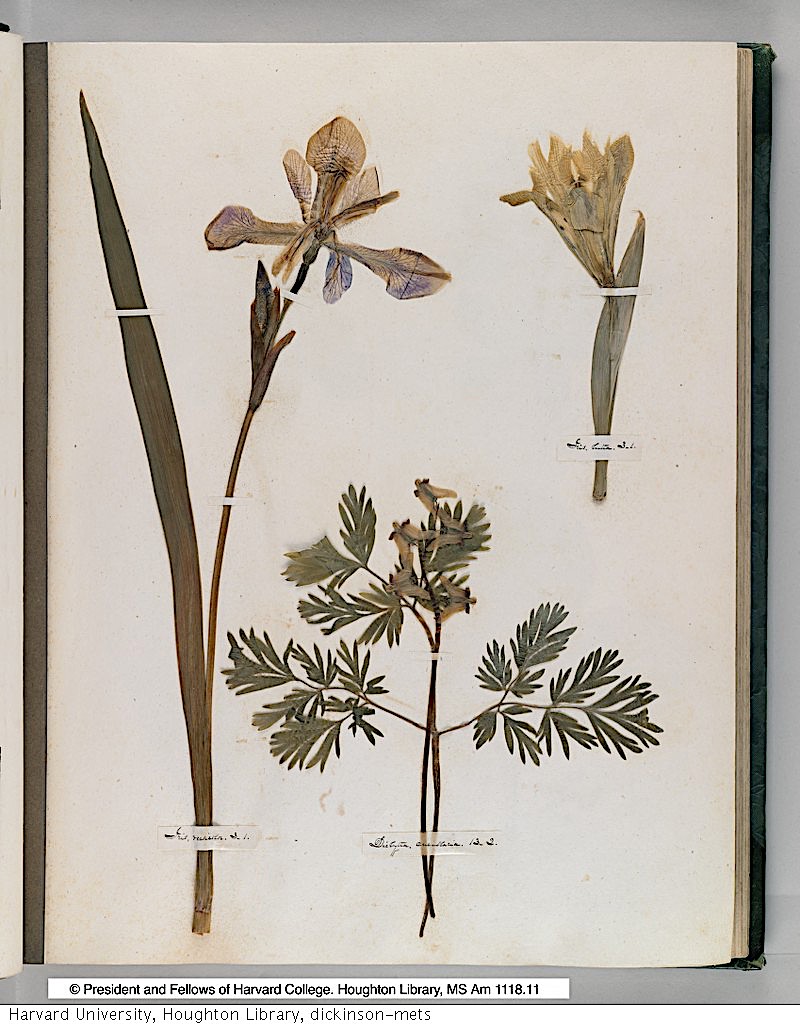
Assembled in a patterned green album bought from the Springfield stationer G. & C. Merriam, the herbarium contains 424 specimens arranged on 66 leaves and delicately attached with small strips of paper. The specimens are either native plants, plants naturalized to Western Massachusetts, where Dickinson lived, or houseplants. Every page is accompanied by a transcription of Dickinson’s neat handwritten labels, which identifies each plant by its scientific name.
The book is thought to have been finished by the time she was 14 years old. Long part of Harvard’s Houghton Library collection, it has also long been treated as too fragile for anyone to view. The only access has come in the form of grainy, black and white photographs. For the past few years, however, scholars and lovers of Dickinson’s work have been able to see the herbarium in these stunning reproductions.
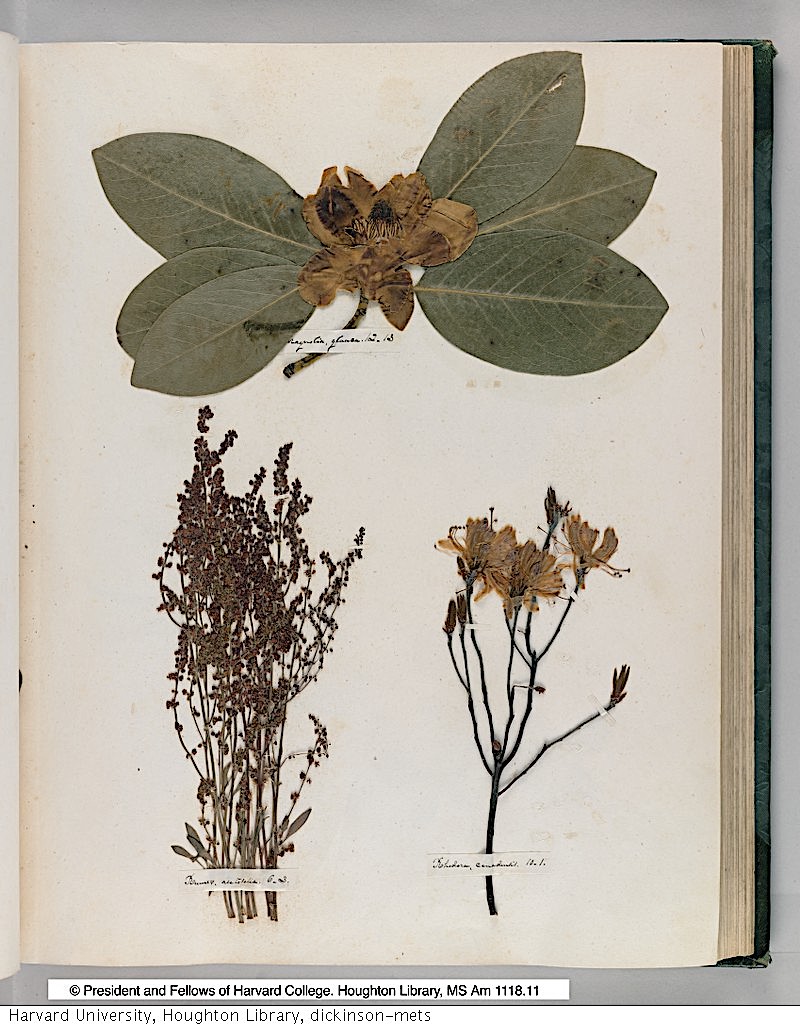
The pages are so formally composed they look like paintings from a distance. Though mostly unknown as a poet in her life, Dickinson was locally renowned in Amherst as a gardener and “expert plant identifier,” notes Sara C. Ditsworth. The herbarium may or may not offer a window of insight into Dickinson’s literary mind. Houghton Library curator Leslie A. Morris, who wrote the forward to the facsimile edition, seems skeptical. “I think that you could read a lot into the herbarium if you wanted to,” she says, “but you have no way of knowing.”
And yet we do. It may be impossible to separate Dickinson the gardener and botanist from Dickinson the poet and writer. As Ditsworth points out, “according to Judith Farr, author of The Gardens of Emily Dickinson, one-third of Dickinson’s poems and half of her letters mention flowers. She refers to plants almost 600 times,” including 350 references to flowers. Both her herbarium and her poetry can be situated within the 19th century “language of flowers,” a sentimental genre that Dickinson made her own, with her elliptical entwining of passion and secrecy.
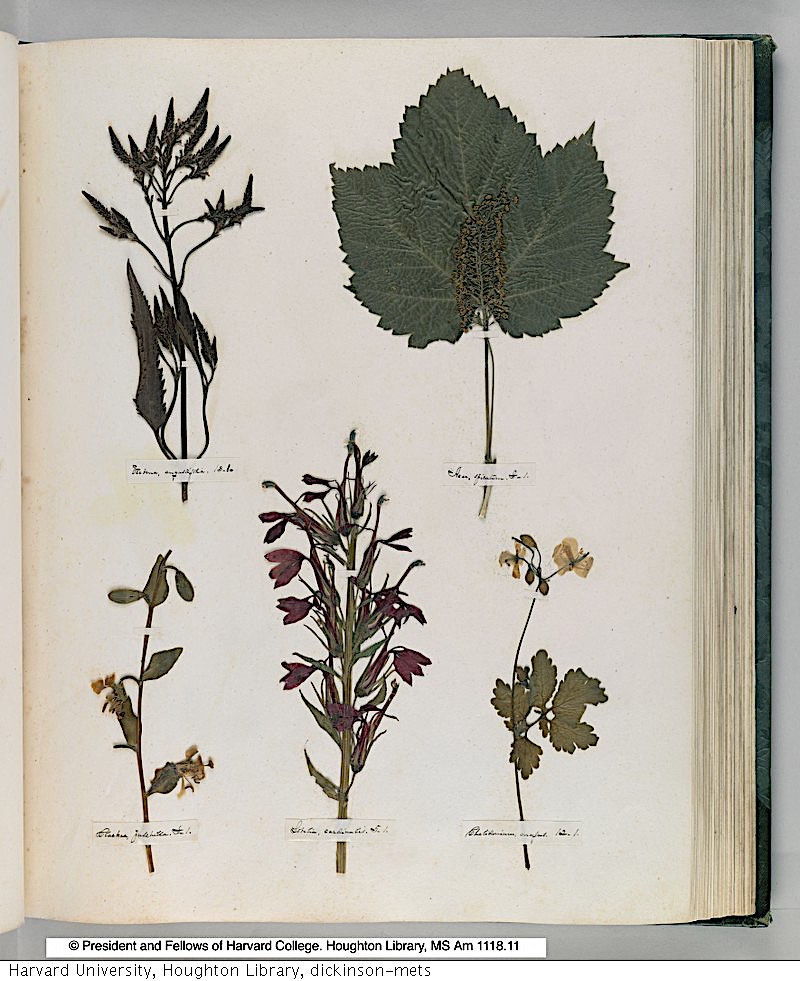
The first two specimens in Dickinson’s herbarium are the jasmine and the privet: “You have jasmine for poetry and passion” in the language of flowers, Morris points out, “and privet,” a hedge plant, “for privacy.” There is no need to see this arrangement as a prediction of the future from the teenage botanist Dickinson. Did she plan from adolescence to become a recluse poet in later life? Perhaps not. But we can certainly “read into” the language of her herbarium some of the same great themes that recur over and over in her work, carried across by images of plants and flowers. See Dickinson’s complete herbarium at Harvard Library’s digital collections here, or purchase a (very expensive) facsimile edition of the book here.
Note: Note: An earlier version of this post appeared on our site in 2019.
Related Content:
How Emily Dickinson Writes A Poem: A Short Video Introduction
The Second Known Photo of Emily Dickinson Emerges
Josh Jones is a writer and musician based in Durham, NC. Follow him at @jdmagness
You have received those odd text messages from a stranger. (“Hi, This is Anita. Have you received the Panamera parts yet?”) You know the messages are spam, but you don’t quite understand the angle of the scam. Above, the Search Engine podcast works with Bloomberg reporter Zeke Faux to break down the con operation. The story turns out to be more complicated than it first appears. It involves crypto, but also human trafficking and forced labor compounds in Cambodia and Myanmar. We’ll just leave it at that and suggest you listen to this unnerving podcast episode. You can hopefully stream it above or find it on your favorite podcast platform—e.g., Apple and Spotify.

Studio Ghibli fans are still pondering the meaning of Hayao Miyazaki’s The Boy and the Heron, which came out last year. Though by some measure the studio’s most lavish feature yet — not least by the measure of it being the most expensive film yet produced in Japan — it’s also the one least amenable to simple interpretation. Even more so than in his previous work, Miyazaki seems to have intended to make a movie less to be explained than to be experienced. Just as the titular young protagonist descends into a bizarre but captivating underworld and returns, changed, to reality, so does the viewer.

If you’ve seen The Boy and the Heron, hearing its very title (which in Japan is 君たちはどう生きるか, or How Do You Live?) will bring back to mind a host of vivid images: the roving back of bulbous-featured grannies obsessed with non-perishable foodstuffs; the posturing of the middle-age Birdman, stuffed into his avian flight suit; the pyrotechnic feats of the young Lady Himi; and above all, perhaps, the floating cascades of Warawara, those adorably round spirits who — in painstaking Ghibli fashion — appear to have been animated individually, each with its own personality. Now, you can download stills from these and other scenes at Studio Ghibli’s official web site.

These come as an expansion to Ghibli’s existing collection, previously featured here on Open Culture, of free-to-download images from their library of titles. They’re offered, the site explains, “solely for personal use by individual fans to further enjoy Studio Ghibli films.” And indeed, they may have no effect stronger than making you want to watch The Boy and the Heron again, the more deeply to feel what Miyazaki intended with his “final” picture. Not that the latest of his retirements has stuck: last fall, Ghibli president Toshio Suzuki reported that the octogenarian Miyazaki was back in the office, planning his next film. If he has more realms yet to explore, animation-lovers around the world will surely follow him. Find the images from The Boy and the Heron here.

via My Modern Met
Related content:
Studio Ghibli Producer Toshio Suzuki Teaches You How to Draw Totoro in Two Minutes
Software Used by Hayao Miyazaki’s Animation Studio Becomes Open Source & Free to Download
Based in Seoul, Colin Marshall writes and broadcasts on cities, language, and culture. His projects include the Substack newsletter Books on Cities, the book The Stateless City: a Walk through 21st-Century Los Angeles and the video series The City in Cinema. Follow him on Twitter at @colinmarshall or on Facebook.

Los Pollos Hermanos, Madrigal Electromotive, Mesa Verde Bank and Trust, Davis & Main: Attorneys at Law—all of these brands come from the Breaking Bad/Better Call Saul universe. They also appear in the Fictional Brands Archive, a website dedicated to “fictional brands found in films, series and video games.” Taking the brands seriously as brands, the site draws on research from a new book written by Lorenzo Bernini entitled Fictional Brand Design. And, with its many entries, the site provides a “comprehensive view of each fictional brand, framing them in their own fictional context and documenting their use and execution in source work.”
Other notable brands include Acme (Looney Tunes), ATN News (Succession), Dunder Mifflin (The Office), Federal Motor Corporation (Fight Club), both Grand Budapest Hotel and Mendl’s (Grand Budapest Hotel), and Nakatomi Corporation (Die Hard). Enter the Fictional Brands Archive here.
Related Content
40 Years of Saul Bass’ Groundbreaking Title Sequences in One Compilation
Here in the twenty-twenties, a hopeful young novelist might choose to enroll in one of a host of post-graduate programs, and — with luck — there find a willing and able mentor. Back in the nineteen-thirties, things worked a bit differently. “In the spring of 1934, an aspiring writer named Arnold Samuelson hitchhiked from Minnesota to Florida to see if he could land a meeting with his favorite author,” says Nicole Bianchi, narrator of the InkWell Media video above. “The writer he had picked to be his mentor? Ernest Hemingway.”
What Hemingway offered Samuelson was something more than a literary mentorship. “This young man had one other obsession,” Hemingway writes in a 1935 Esquire piece. “He had always wanted to go to sea.” And so “we gave him a job as a night watchman on the boat which furnished him a place to sleep and work and gave him two or three hours’ work each day at cleaning up and a half of each day free to do his writing.” To Hemingway’s irritation, Samuelson proved not just a clumsy hand on the Pilar, but a fount of questions about how to craft literature — something Hemingway gives the impression of considering easier done than said.
Nevertheless, in the Esquire piece, Hemingway condenses this long back-and-forth with Samuelson into a dialogue containing lessons that “would have been worth fifty cents to him when he was twenty-one.” He first declares that “good writing is true writing,” and that such truth depends on the writer’s conscientiousness and knowledge of life. As for the value of imagination, “the more he learns from experience the more truly he can imagine.” But even the most world-weary novelist must “convey everything, every sensation, sight, feeling, place and emotion to the reader,” and that requires round after round of revision, so you might as well do the first draft in pencil.
As far as the writing itself, Hemingway recommends reading over at least your last two or three chapters at the start of each day, and repeats his well-known dictum always to leave a little water in the well at the end so that “your subconscious will work on it all the time.” But all will be for naught if you haven’t read enough great books so as to “write what hasn’t been written before or beat dead men at what they have done.” Don’t compete with living writers, whom Hemingway saw as propped up by “critics who always need a genius of the season, someone they understand completely and feel safe in praising, but when these fabricated geniuses are dead they will not exist.”
The video focuses on a series of mental exercises Hemingway explains to Samuelson. Recall an exciting experience, such as that of catching a fish, and “find what gave you the emotion, what the action was that gave you the excitement. Then write it down making it clear so the reader will see it too and have the same feeling you had.” Remember conflicts and try to understand all the points of view: “If I bawl you out try to figure out what I’m thinking about as well as how you feel about it. If Carlos curses Juan think what both their sides of it are. Don’t just think who is right.” When other people talk, “listen completely. Don’t be thinking what you’re going to say.”
Underlying this characteristically straightforward advice is the commandment to find ways out of your own head and into the perspective of the rest of humanity. The necessary habits of observation can be cultivated anywhere: at sea, yes, but also in the city, where you can “stand outside the theatre and see how people differ in the way they get out of taxis or motor cars.” In the event, Samuelson never did become a novelist, though he did write a memoir about his year under Hemingway’s tutelage. Whatever the experience taught Samuelson, it brought Hemingway to a resolution of his own: “If any more aspirant writers come on board the Pilar let them be females, let them be very beautiful and let them bring champagne.”
Related content:
7 Tips From Ernest Hemingway on How to Write Fiction
The (Urban) Legend of Ernest Hemingway’s Six-Word Story: “For sale, Baby shoes, Never worn”
Ernest Hemingway Creates a Reading List for a Young Writer (1934)
Based in Seoul, Colin Marshall writes and broadcasts on cities, language, and culture. His projects include the Substack newsletter Books on Cities, the book The Stateless City: a Walk through 21st-Century Los Angeles and the video series The City in Cinema. Follow him on Twitter at @colinmarshall or on Facebook.
Fallacies—notes Purdue’s Writing Lab—“are common errors in reasoning that will undermine the logic of your argument. Fallacies can be either illegitimate arguments or irrelevant points, and are often identified because they lack evidence that supports their claim. Avoid these common fallacies in your own arguments and watch for them in the arguments of others.” Purdue’s website then highlights a number of the mental traps that students often fall into—for example, the slippery slope, begging the claim, circular arguments, the red herring, and more. But if you want a rapid-fire introduction to many more logical fallacies, look no further than the video above. In 11 minutes, you will come across ones you may not have known about before—from the No True Scotsman and the Texas Sharpshooter, to the Tu QuoQue and the Ignoratio Elenchi. But it also has some timeless ones we see every day. Indeed who among us hasn’t experienced the Sunk Cost Fallacy at work, or the Ad Hominem attack on TV?
Related Content
Daniel Dennett Presents Seven Tools For Critical Thinking
Philosophy Referee Hand Signals
When did you last send someone a photo? That question may sound odd, owing to the sheer commonness of the act in question; in the twenty-twenties, we take photographs and share them worldwide without giving it a second thought. But in the nineteen-thirties, almost everyone who sent a photo did so through the mail, if they did it at all. Not that there weren’t more efficient means of transmission, at least to professionals in the cutting-edge newspaper industry: as dramatized in the short 1937 documentary above, the visual accompaniment to a sufficiently important scoop could also be sent in mere minutes through the miracle of wire.
“Traveling almost as fast as the telephone story, wired photos now go across the continent with the speed of light,” declares the narrator in breathless newsreel-announcer style. “It’s not a matter of sending the whole picture at once, but of separating the picture into fine lines, sending those lines over a wire, and assembling them at the other end.”
Illustrating this process is a clever mechanical prop involving two spindles on a hand crank, and a length of rope printed with the image of a car that unwinds from one spindle onto the other. To ensure the viewer’s complete understanding, animated diagrams also reveal the inner workings of the actual scanning, sending, and receiving apparatus.
This process may now seem impossibly cumbersome, but at the time it represented a leap forward for mass visual media. In the decades after the Second World War, the same basic principle — that of disassembling an image into lines at one point in order to reassemble it at another — would be employed in the homes and offices of ordinary Americans by devices such as the television set and fax machine. We know, as the viewers of 1937 didn’t, just how those analog technologies would change the character of life and work in the twentieth century. As for what their digital descendants will do to the twenty-first century, as they continue to break down all existence into not lines but bits, we’ve only just begun to find out.
Related content:
The History of Photography in Five Animated Minutes: From Camera Obscura to Camera Phone
Watch a Local TV Station Switch From Black & White to Color for First Time (1967)
Creative Uses of the Fax Machine: From Iggy Pop’s Bile to Stephen Hawking’s Snark
From the Annals of Optimism: The Newspaper Industry in 1981 Imagines its Digital Future
Based in Seoul, Colin Marshall writes and broadcasts on cities, language, and culture. His projects include the Substack newsletter Books on Cities, the book The Stateless City: a Walk through 21st-Century Los Angeles and the video series The City in Cinema. Follow him on Twitter at @colinmarshall or on Facebook.
Aldous Huxley put himself forever on the intellectual map when he wrote the dystopian sci-fi novel Brave New World in 1931. (Listen to Huxley narrating a dramatized version here.) The British-born writer was living in Italy at the time, a continental intellectual par excellence.
Then, six years later, Huxley turned all of this upside down. He headed West, to Hollywood, the newest of the New World, where he took a stab at writing screenplays (with not much luck) and started experimenting with mysticism and psychedelics — first mescaline in 1953, then LSD in 1955. This put Huxley at the forefront of the counterculture’s experimentation with psychedelic drugs, something he documented in his 1954 book, The Doors of Perception.
Huxley’s experimentation continued until his death in November 1963. When cancer brought him to his deathbed, he asked his wife to inject him with “LSD, 100 µg, intramuscular.” He died tripping later that day, just hours after Kennedy’s assassination. Three years later, LSD was officially banned in California.
By way of footnote, it’s worth mentioning that the American medical establishment is now giving hallucinogens a second look, conducting controlled studies of how psilocybin and other psychedelics can help treat patients dealing with cancer, obsessive-compulsive disorder, post-traumatic stress disorder, drug/alcohol addiction and end-of-life anxiety.
For a look at the history of LSD, we recommend the 2002 film Hofmann’s Potion by Canadian filmmaker Connie Littlefield. You can watch it here.
If you would like to sign up for Open Culture’s free email newsletter, please find it here. Or follow our posts on Threads, Facebook, BlueSky or Mastodon.
If you would like to support the mission of Open Culture, consider making a donation to our site. It’s hard to rely 100% on ads, and your contributions will help us continue providing the best free cultural and educational materials to learners everywhere. You can contribute through PayPal, Patreon, and Venmo (@openculture). Thanks!
Related Content:
Ken Kesey’s First LSD Trip Animated
Hear Aldous Huxley Narrate His Dystopian Masterpiece, Brave New World
Aldous Huxley Predicts in 1950 What the World Will Look Like in the Year 2000
What did ancient Egyptians sound like? What did they eat and drink? What ancient Egyptian medicine and tools do we still use in modern times? Why did they practice mummification? Above, Laurel Bestock, a professor from Brown University, discusses everything you ever wanted to know about Ancient Egypt. Not a stranger to popular media productions—Bestock appears in a recent National Geographic production, Egypt’s Lost Wonders—the professor fields every question that comes her way, no matter how big or small. All along, she gives “outstanding and very down-to-earth explanations,” notes a fellow professor in the YouTube comments. For my money, the best part comes at the 10:40 mark when she deciphers and reads hieroglyphs. Enjoy.
If you would like to sign up for Open Culture’s free email newsletter, please find it here. Or follow our posts on Threads, Facebook, BlueSky or Mastodon.
If you would like to support the mission of Open Culture, consider making a donation to our site. It’s hard to rely 100% on ads, and your contributions will help us continue providing the best free cultural and educational materials to learners everywhere. You can contribute through PayPal, Patreon, and Venmo (@openculture). Thanks!
Related Content
How to Read Ancient Egyptian Hieroglyphs: A British Museum Curator Explains

If we want to know the precise geographical location of, say, a particular church in Madrid, video arcade in Tokyo or coffee shop in Addis Ababa, we can figure it out in a matter of seconds. This is, in historical terms, a recent development indeed: many of us remember when the most detailed cartographical information we could get about distant lands (or for that matter, most of our own land) revealed to us only its cities and major roads — assuming we even had a world atlas at hand. Now, younger people take for granted the knowledge of not just where every place in the world is, but what it looks like, what its prices are, and what its visitors have said about it.
We live today, in other words, in the dream of Fra Mauro, the Venetian cartographer-monk of the late Middle Ages who created the most detailed and accurate world map to that point in human history. “As a young man, Fra Mauro had been a soldier and merchant of the famed Venice Merchant Fleet,” says the site of New World Cartographic. “His travels with the fleet around the Mediterranean and the Middle East resulted in his becoming interested in mapping, and he eventually settled in the monastery of San Michelle on the island of Murano, in the Venice Lagoon, where he became a lay brother.” In the early 1450s, “he was commissioned by King Afonso V of Portugal to create a map of the world.”
Portugal’s will to dominate world trade, which required the most detailed maps possible, was matched by Fra Mauro’s will to gather information about every corner of Earth, no matter how far-flung. And he could do that without leaving Venice: as Atlas Obscura’s Adam Kessler writes, “Arab traders and world explorers passed through the port, giving Fra Mauro an incomparable source of gossip and tall tales about the world. The fall of Constantinople, occurring a few years before the map was finished, would also have provided a rich source of well-traveled refugees, presumably willing to swap their stories for some bread or beer.” Not only did the map’s physical creation require a team of collaborators, the gathering of its contents relied upon the fifteenth-century equivalent of crowdsourcing.
This chapter of cartographical history invites such technological analogies: Kessler calls Fra Mauro’s completed mappa mundi “the Google Earth of the 1450s.” Despite his religious affiliation with the monastery of San Michele, Fra Mauro’s efforts produced an unprecedentedly radical rendition of the world. Breaking with religious tradition, he didn’t put Jerusalem in the center; “the Garden of Eden was relegated to a sidebox, not shown in a real geographic location.” His scrupulousness made him the first cartographer “to depict Japan as an island, and the first European to show that you could sail all the way around Africa.” While his map was “the most accurate ever made at the time,” its more than 3,000 annotations do contain plenty of tall tales, often of literal giants. But are they really much less trustworthy than the average twenty-first-century user review?
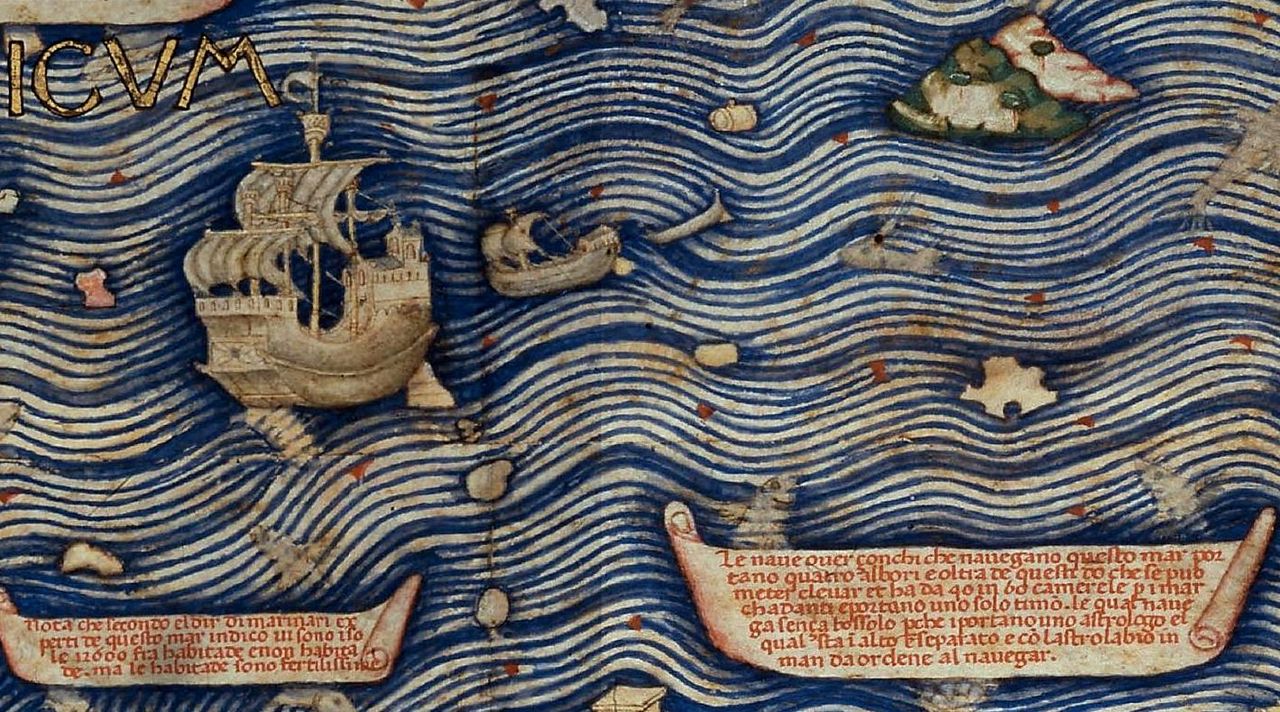
Related Content:
The World Map That Introduced Scientific Mapmaking to the Medieval Islamic World (1154 AD)
Explore the Hereford Mappa Mundi, the Largest Medieval Map Still in Existence (Circa 1300)
Europe’s Oldest Map: Discover the Saint-Bélec Slab (Circa 2150–1600 BCE)
Based in Seoul, Colin Marshall writes and broadcasts on cities, language, and culture. His projects include the Substack newsletter Books on Cities, the book The Stateless City: a Walk through 21st-Century Los Angeles and the video series The City in Cinema. Follow him on Twitter at @colinmarshall or on Facebook.